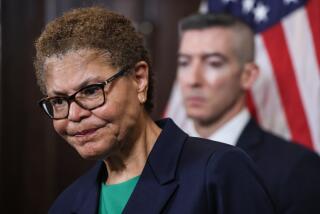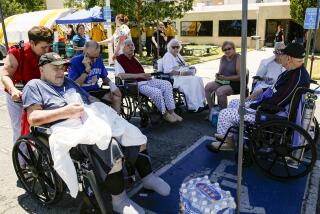County Health System Faces Dire Options
- Share via
Under one scenario, Los Angeles County would have to cut the number of public hospital beds in half, convert all but three of its six hospitals into clinics and eliminate more than 8,000 jobs--unless it got substantial financial help.
And that’s not even the most pessimistic scenario. It is just one of three draft plans obtained Wednesday by The Times mapping out the sort of dramatic changes that would be needed to close the county’s $688-million budget deficit projected for 2005.
The plans provide the most detailed sketches yet of what the county’s medical system might look like if the state and federal governments do not provide significantly more funding for the county Department of Health Services.
Facing dwindling federal aid, department officials are poised to recommend deep cuts to the Board of Supervisors next month and hope to close the gap by October.
Dr. Thomas Garthwaite, the new director of the health department, stressed in an interview that the scenarios could change but said the options under consideration illustrate the magnitude of the changes coming.
“It’s hard to imagine services won’t be impacted,” Garthwaite said.
Under the most pessimistic scenario, which assumes that the county makes no financial reforms, all hospitals but County-USC Medical Center in Boyle Heights and Martin Luther King Jr./Drew Medical Center in Willowbrook would close, as would the more than 100 public health clinics scattered across the county.
That option is unlikely. “They should fire me if I recommend doing nothing,” Garthwaite said.
Under the most optimistic plan, the county would have to close the emergency room at Harbor-UCLA Medical Center near Torrance, eliminate trauma services at King/Drew, cut the number of beds at Olive View-UCLA Medical Center in Sylmar and convert High Desert Hospital in Lancaster into a beefed-up outpatient clinic.
That option assumes that the county gets extra help from Washington--by no means a sure bet.
The scenario that best reflects the county’s present circumstances calls for converting Harbor-UCLA and Olive View-UCLA into large-scale outpatient clinics, shrinking High Desert Hospital into a clinic and requiring that Rancho Los Amigos Medical Center, a rehabilitation center, become independent of the department.
That option presumes that the county gets no aid from any other branch of government and so must drastically streamline the way it delivers medical care.
Garthwaite said he may borrow from all three draft plans in making his recommendations to the supervisors in June.
Each scenario represents an effort to shift the county’s heavily hospital-based health system to a cheaper outpatient model, an undertaking that has been urged by some health reformers but faces an array of political and financial obstacles.
Hospitals are popular among politicians and public-sector unions, and the federal government reimburses counties for treating patients in hospitals, not clinics.
An official at the union representing most of the health department’s 22,000 employees said the scenarios underscore that elected officials have to get serious about fixing the deficit.
“If the purpose of laying out these cuts is to sound the alarm, that’s a good thing,” said Bart Diener, assistant general manager of Service Employees International Union Local 660. “The worst thing is fatalism, and we’re seeing a little bit too much of that from our elected officials.”
Dr. Brian Johnston, past president of the Los Angeles County Medical Assn., was also aghast. “When you look at the numbers, it’s obvious that something drastic has to change,” he said. “I wish the drastic change was that we opened our eyes and decided we need to find funding.”
The deficit stems largely from the fact that the county health system treats many of the nearly 3 million uninsured patients in Los Angeles County. Over the years, the county has lost funding while the number of uninsured people has grown.
In 1995, a $1-billion federal bailout rescued the county from bankruptcy.
After failing to sufficiently streamline its health system, the county nonetheless won another bailout in 2000. But federal officials then suggested that there not be a third bailout in 2005.
Still, the county is trying to negotiate additional aid from Washington. County officials traveled there last month to speak to the Bush administration about new possibilities for assistance. Those include giving the health money directly to Los Angeles as a block grant--as opposed to dictating how the county spends its funds--and allowing the county to be reimbursed for outpatient care. Garthwaite said he is optimistic about those discussions.
It is a difficult time, though, to get help from other branches of government. The state faces a $22-billion deficit, and the Bush administration has fewer ties to heavily Democratic Los Angeles County than the Clinton administration, which authorized the two previous bailouts.
The supervisors could buy themselves some time. The county has about $500 million in one-time reserves it could use to try to close the deficit, but that would be a temporary, and some officials believe fiscally imprudent, fix.
Garthwaite said that even without a financial crisis, certain changes have to be made. He has repeatedly suggested centralizing complex services such as heart surgery at County-USC, the county’s largest hospital, for example.
In all of the draft plans, high-end medical services would be centralized at the Boyle Heights hospital. Even in the more optimistic scenario, the county would pull two of its hospitals--Harbor and King/Drew--from the trauma network, an array of specialized emergency rooms that treat patients injured in such circumstances as gunfights or traffic accidents.
Johnston, the past medical board president and an emergency room physician, said he was alarmed at that option.
“They should put out a public announcement in some of these communities that if something bad happens to you, you are on your own,” he said. “That’s a very busy trauma center,” he added, referring to King/Drew. “What’s going to happen to those people?”







